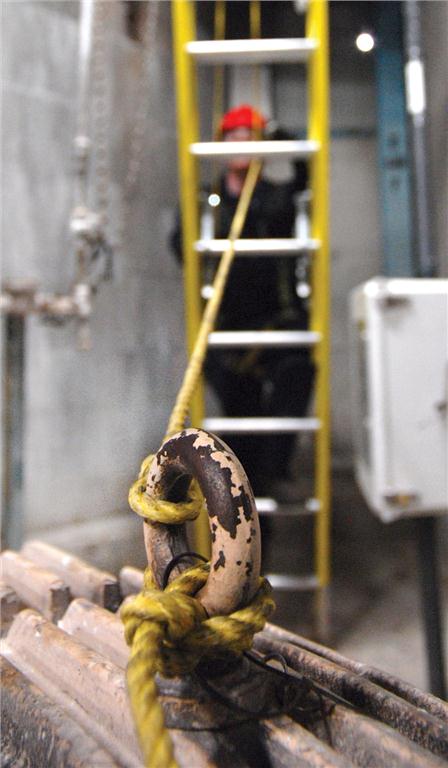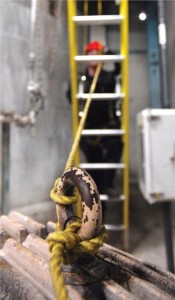
Climbing the Safety Ladder
Walking along a mill’s machinery-lined corridor on a tour, I stumbled on an asphalt ramp between the floor and a five-inch high doorsill. Once painted yellow, little of the warning colour remained. I turned to Michel Cloutier, my host and...
June 1, 2013 | By By Carroll McCormick
 Photo: Carroll McCormick. Many small considerations, such as this ladder tie-off, contribute to Domtar's award-winning safety program.
Photo: Carroll McCormick. Many small considerations, such as this ladder tie-off, contribute to Domtar's award-winning safety program. 
Photo: Carroll McCormick. Many small considerations, such as this ladder tie-off, contribute to Domtar’s award-winning safety program.
Walking along a mill’s machinery-lined corridor on a tour, I stumbled on an asphalt ramp between the floor and a five-inch high doorsill. Once painted yellow, little of the warning colour remained. I turned to Michel Cloutier, my host and the maintenance superintendent at Domtar’s pulp and paper mill in Windsor, QC, and said, “I think that was a near miss.” He whipped out a notebook and scribbled a few words.
I was at the mill to learn some of the techniques Domtar uses to improve worker safety in its maintenance practices. Reporting and analyzing near misses, that is, close calls or near accidents, is one of the ways Domtar improves safety and I had just treated myself to an example.
“With a near miss, we do the same report as with an accident, including corrective measures,” Cloutier explains. “We have had near miss reporting for a while, but put additional focus on it in 2012. We’ve tripled the number of reports compared to three years ago.”
Near misses help management and employees recognize, report and then communicate potential hazards to all employees. “Reporting near misses is a good thing. You know your culture is going in the right direction,” says Eric Ashby, the Windsor mill manager.
Domtar won the 2012 Paper Week Canada Safety Leadership Award, with just five recordable incidents in the course of 1,483,056 hours worked. Achieving such a record and creating a positive safety culture is a continual effort. “There are a multitude of items we are working on, on a daily basis, to move from a reactive to a proactive culture. People that tell themselves that it is one thing will miss the boat,” Ashby explains.
In 2009 Domtar introduced the concept of the sphere de sécurité, or safety sphere. Think of it as an imaginary, three-metre-diameter bubble that travels around with you, the interior of which you constantly analyze for danger. “It’s quite basic, but when you are reminded of it every day, it becomes second nature. That is what we are trying to do. Look up, look down, look for traffic, etc. The safety sphere is part of our basic safety analysis,” Cloutier explains.
Domtar produced another aid in late 2011 that helps workers remember to analyze the safety sphere and perform other safety checks as they prepare for a job. It is a pocket-sized booklet, called ‘J’analyse la tâche’ (‘I am analyzing the task’) and everyone carries one with them. On the front of each page is a yes/no checklist of 11 items; e.g., are there any risks associated with my safety sphere; is there a risk of being distracted or losing my balance; am I working with a new colleague; do I need to coordinate with another team; do I need to control any sources of energy? On the back of the page, workers can note dangers they spot and the controls they put in place.
“We specify that the pages be filled out when going on a job that is not common or done every day. Filling out a page in the booklet is not mandatory, but we want to get people into the habit of doing it,” Cloutier says.
Domtar’s management promotes these habits. For example, the maintenance supervisor discusses the safety sphere at safety meetings. Before someone goes out on a job, a supervisor will review the safety checklist and protocols. “We have it set up from the top down. The supervisor has a big role in this. Our safety coordinator and our safety guy from the union, their roles have been refined to focus just on safety,” Cloutier explains.
New employees are taught to think about safety during a four-day introduction to the mill. They spend two of those days on health and safety, and lock-out procedures. “Let’s say a millwright comes into my area. There is a specific introduction into that area. We started doing that last year. We discuss things like lift trucks, specific machines, heat and pinch points. We discuss winders, overhead cranes (you can’t walk under a loaded crane) chemicals and heights (you need three points of support or to be attached with a harness).”
Risk assessment
Risk assessment is a big deal at Domtar. Noting that workers were cutting their hands with utility knives, for example, the mill banned them and purchased safer cutting tools. “Banning them was a big change, but the new workers [of the future] will privately think, ‘I don’t believe they ever used those razor-sharp things’,” Cloutier predicts.
Three years ago, Domtar banned safety shoes and mandated six-inch safety boots. There is more emphasis on wearing gloves. For instance, Cloutier says, “We have a rule that you have to wear gloves when you use knives or doctor blades (blades used to scrape rollers).”
Special clothing or equipment may be specified in work orders. Before doing certain electrical tasks, for example, specialized safety equipment may be required, such as Level 2 arc flash clothing for electrical hot spots and hearing protectors, glasses and shields for protection against arc flash. “There is a company-wide program to promote electrical safety according to Canadian and US norms. There is a lot of auditing,” Cloutier says.
Proper tool use
Using the proper tools is another focus. Maintenance workers are already discouraged from using adjustable wrenches for big bolts, and a more comprehensive tool inspection is under development. “We have had some in the past but it wasn’t anything formal. Formal is ‘if you do a tool inspection, what do you look for?’ This new process came from a corporate health and safety audit,” Cloutier explains.
Also, three years ago, the mill introduced a formal, documented sling inspection program. A corporate health and safety audit led to a simple, effective aid the company adopted last year to identifying slings that have passed inspection: a blue inspection tag to show that it has been independently tested.
Lockouts
Lockouts and paper machine shutdowns are a big topic of conversation, Cloutier says. “We are always working to refine our procedures and have done a lot of work in the past few months on lockouts and shutdowns. On the last paper machine shutdown, for example, the lockout team spent about 40% more time preparing for and executing the lockout – about 24 hours in all.
One change is to restrict access to the paper machine when installing press felt because the rolls can turn. “We are installing additional mechanical stoppers to prevent dryer rolls from turning when we install dryer felts. Another important lockout procedure that the mill has improved is the verification of the drainage of pipes. We have had a few near misses with that,” Cloutier says.
With the help of the Associations de la santé et de la sécurité des pâtes et papiers et des industries de la forêt du Québec (there is no official English version, but it translates as Quebec associations of health and safety of the pulp and paper and forest industries) the mill is looking to improve the ways motor test starts are done.
Other outside sources the mill has tapped for assistance include the Commission de la santé et de la sécurité du travail (CSST) — the province’s workplace health and safety commission, and a company that makes safety videos.
Drive coupling guards
Based on a CSST province-wide pinch points program, about five years ago the mill began replacing the guards on drive couplings. This was not because of any accidents or complaints, but rather, the initiative recognized that couplings are one of the biggest pinch point areas.
Domtar has an ongoing program to install beefy bright red guards during every shutdown. The mill has installed hundreds of them so far, with more to come.
Getting workers talking about safety helps change a safety culture. At Domtar, safety videos have been a great catalyst for discussion. A union safety representative by the name of Sam Lussier produces safety videos for Domtar, using union members as actors. His company, Sam Sécure, has produced videos on topics such as hearing protectors, hand tools, burn out, distractions and forklift forks.
The maintenance workers have seen them all, Cloutier says. “They are done from the point of view of worker safety, not management or unions. I think they are very well perceived. There is normally a lot of interaction during the presentation of these videos.”
The videos also speak to corporate initiatives such as the courage to intervene if a worker sees a potentially dangerous situation or recognizes that a colleague might be in the wrong frame of mind to do a job safely.
A worker’s state of mind
“Rushing, frustration, fatigue and complacency are related to safety performance. The likelihood of incidents is higher if employees are not on task. We have people acknowledge that these four states of mind can affect performance,” Ashby explains.
Cloutier comments, “We have said that when a supervisor is assigning someone a task, make sure he is up to it. If the person says he is not, our response will not be, ‘go out and do the job anyway’.”
Most people of a certain age are well aware of how macho work environments reward bravado, but this attitude is changing, according to Cloutier. Take the sharing of accident stories, a proven way to prevent the same mistakes from recurring in different mills. “I shared a story a couple of weeks ago about a death in St-Jérôme. People listened. Years ago they might have walked out of that talk, but not now. The culture is changing.”
By the way, Cloutier wrote up a work order, and the ramp I stumbled on has been repainted.
Carroll McCormick, our senior contributing editor, is based in Montreal. He has been writing award-winning articles for us for the past 15 years.
